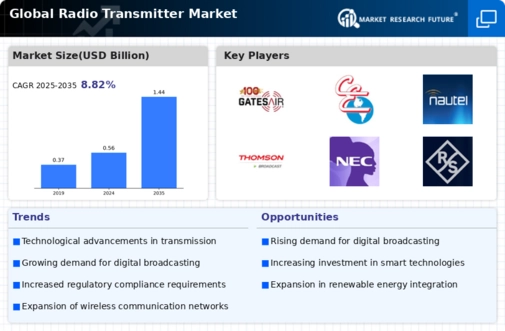Top Industry Leaders in the Radio Transmitter Market

Competitive Landscape of Radio Transmitters Market
The radio transmitter market, a crucial cog in the machinery of wireless communication, pulsates with dynamic competition. Established giants vie for dominance, while agile startups seek to disrupt the scene. Understanding this landscape is paramount for navigating its currents and securing a winning position.
Strategies Adopted by Key Players:
- Innovation Prowess: Embracing cutting-edge technologies, like software-defined radios and cognitive communications, is crucial for market differentiation. Players like ViaSat and Harris Corporation excel in this space with their focus on advanced modulation techniques and software-intensive platforms.
- Cost Optimization: With price sensitivity across many segments, optimizing production processes and offering cost-effective solutions is vital. Manufacturers like GatesAir and Nautel have capitalized on economies of scale and lean manufacturing methodologies to gain traction.
- Partnership Power: Forging strategic partnerships with system integrators, content providers, and research institutions broadens reach and fosters innovation. For instance, the collaboration between Collins Aerospace and Airtel enabled efficient deployment of advanced aviation communication systems in India.
- Diversification Playbook: Diversifying product portfolios to cater to emerging segments like the Internet of Things (IoT) and connected vehicles opens new avenues for growth. Companies like Hytera Communications are actively developing low-power, high-efficiency transmitters for these burgeoning markets.
Factors Shaping Market Share: A Multifaceted Equation
- Technological Leadership: Early adoption of cutting-edge technologies can provide a significant competitive edge.
- Customer Service and Support: Offering reliable and responsive after-sales support is crucial for building trust and loyalty.
- Geographical Reach: Strong presence in key markets and regions can significantly impact market share.
- Regulatory Compliance: Navigating complex regulations and obtaining necessary licenses is essential for market access.
- Pricing and Value Proposition: Striking the right balance between affordability and product features is key to attracting and retaining customers.
New and Emerging Companies:
The radio transmitter market is constantly witnessing the emergence of new companies, particularly in the digital and software-defined radio segments. These startups often bring fresh perspectives and innovative solutions to the table, challenging the established players. Some key examples include:
- Limelight Networks: Offering cloud-based radio transmission solutions for broadcasters.
- Ettus Research: Developing open-source SDR platforms for amateur radio enthusiasts.
- RF Elements: Specializing in high-efficiency, low-power transmitters for various applications.
Latest Company Updates
GatesAir:
- October 26, 2023: GatesAir announced the release of its next-generation Maxiva X5 FM transmitter, boasting increased efficiency, reduced footprint, and improved audio quality.
- July 19, 2023: GatesAir partnered with Xperi to integrate HD Radio technology into its transmitter portfolio, aiming to enhance in-vehicle radio listening experiences.
Broadcast Electronics:
- January 9, 2024: Broadcast Electronics launched its new FM5500HD transmitter, featuring a modular design for efficient maintenance and increased power density.
- November 15, 2023: Broadcast Electronics secured a contract with the United States Air Force to supply FM and HD Radio transmitters for various installations.
